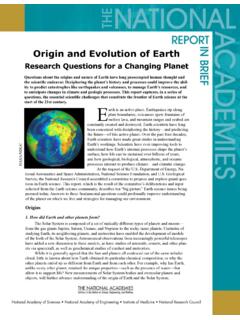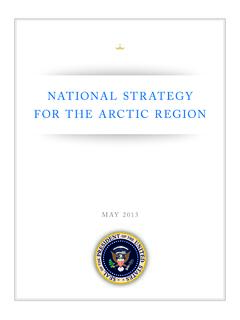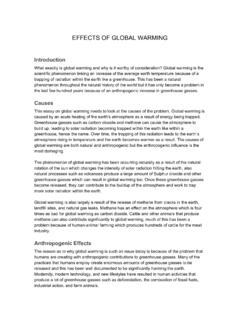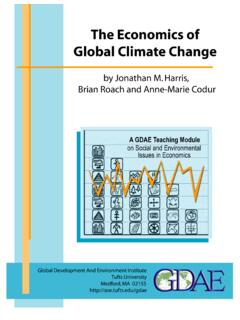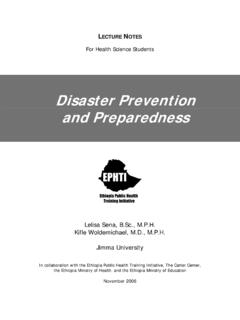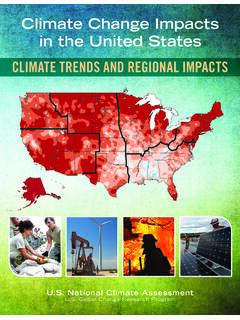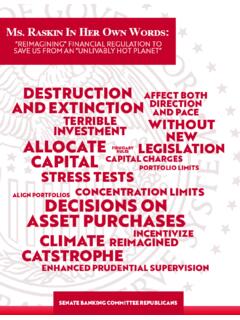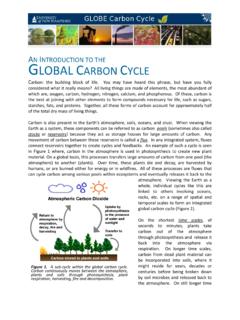Transcription of GREENHOUSE EFFECT & GLOBAL WARMING - The internet …
1 GREENHOUSE EFFECT & GLOBAL WARMING - The internet as the primary source of information- The internet as a resource- Use reputable web sitesGovernment agencies: EPA, NASA, DOE, etcAcademic InstitutionsMuseumsCommercial: companies, science magazines, on Earth would be very different without the GREENHOUSE EFFECT . The GREENHOUSE EFFECT serves to keep the long term annual average temperature of the Earth approximately 32 C higher than the Earth's temperature would be without the GREENHOUSE chemical compounds found in the Earth s atmosphere act as GREENHOUSE gases. These gases allow sunlight, which is radiated in the visible and ultraviolet spectra, to enter theatmosphere unimpeded.
2 When it strikes the Earth s surface, some of the sunlight is reflected as infrared radiation (heat). GREENHOUSE gases tend to absorb this infrared radiation as it isreflected back towards space, trapping the heat in the and GREENHOUSE gasesIntro to IR spectroscopy ~ Spectroscopy and GREENHOUSE of the emission of radiation from the Sun and by the Earth s SurfaceRadiative Equilibrium Temperature of the Earth - is the temperature that the Earth would have with no atmosphere, when infrared emission exactly balances the radiation received by the Sun. If we assume that some of it (say 83%, like modern day Mars) is reflected, the temperature is 260oK.
3 This is about 40ocolder than the temperature , our actual temperature today is ~300 K. The atmosphere is responsible for increasing the actual temperature above theradiative equilibrium temperature. This increase is the so-called GREENHOUSE for calculating the temperature of the Early EarthIR Spectra of Gas Phase on IR absorptions between ~ 5 and 20 or ~ 2000 and 500 cm-1 Examples of GREENHOUSE GasesNameSourceCO2CH4N2 OSF6 HFC s, PFC s New GREENHOUSE Gas Identified, Potent and Rare (but Expanding) - NY Times, July 2000 GREENHOUSE in the atmosphere can contribute to the GREENHOUSE EFFECT both directly and indirectly.
4 Direct effects occur when the gas itself is a GREENHOUSE gas. Indirect radiative forcing occurs when chemical transformations of the original gas produce a gas or gases that are GREENHOUSE gases, when a gas influences the atmospheric lifetimes of other gases, and/or when a gas affects other atmospheric processes that alter the radiative balance of the earth ( , affect cloud formation or albedo). The concept of a GLOBAL WARMING Potential (GWP) has been developed to compare the ability of each GREENHOUSE gas to trap heat in the atmosphere relative to another gas. Carbon dioxide (CO2) was chosen as the reference gas to be consistent with IPCC GWP of a GREENHOUSE gas is the ratio of GLOBAL WARMING , or radiative forcing both direct and indirect from one unit mass of a GREENHOUSE gas to that of one unit mass of carbon dioxide over a period of , all climate changes occurred naturally.
5 However, during the Industrial Revolution, we began altering our climate and environment through changing agricultural and industrial practices. Before the Industrial Revolution, human activity released very few gases into the atmosphere, but now through population growth, fossil fuel burning, and deforestation, we are affecting the mixture of gases in the is reasonable to expect that the Earth should warm as concentrations of GREENHOUSE gases in the atmosphere increase above natural levels, much like what happens when the windows of a GREENHOUSE are closed on a warm, sunny day. This additional WARMING is commonly referred to as GREENHOUSE WARMING is GLOBAL WARMING due to increases in atmospheric GREENHOUSE gases ( , carbon dioxide, methane,chlorofluorocarbons, etc.)
6 , whereas GLOBAL WARMING refers only to the observation that the Earth is WARMING , without any indication of what might be causing the WARMING is accepted as fact by most of the scientific community. However, GREENHOUSE WARMING is more controversial because it implies that we know what is causing the Earth to warm. Although it is known for certain that atmospheric concentrations of these GREENHOUSE gases are rising dramatically due to human activity, it is less well known exactly how increases in these GREENHOUSE gases factor in the observed changes of the Earth's climate and GLOBAL The Common Sense Climate Index (Hansen et al. 1998) is a simple measure of the degree (if any) to which practical climatechange is occurring.
7 The index is a composite of several everyday climate indicators. It is expected to have positive values when WARMING occurs and negative values for cooling. If the Index reaches and consistently maintains a value of 1 or more, the climate change should be noticeable to most people who have lived at that location for a few decades. Goddard Institute for Space Studies (GISS) do we know that temperatures are rising? is the study of past climate. The word is derived from the Greek root "paleo-," which means "ancient," and the term "climate." Paleoclimate is climate that existed before humans began collecting instrumental measurements of weather ( , temperature from a thermometer, precipitation from a rain gauge, sea level pressure from a barometer, wind speed and direction from an anemometer).
8 Instead of instrumental measurements of weather and climate,paleoclimatologists use natural environmental (or "proxy") records to infer past climate each of the temperaturereconstructions are different (due to differing calibration methods and data used), they all show some similar patterns of temperature change over the last several centuries. Most striking is the fact that each record reveals that the 20th century is the warmest of the entire record, and that WARMING was most dramatic after latest peer-reviewedpaleoclimatic studies appear to confirm that the GLOBAL warmth of the 20th century may not necessarily be the warmest time in Earth's history, what is unique is that the warmth is GLOBAL and cannot be explained by natural forcing periods of warmth have been hypothesized to have occurred in the past.
9 However, upon close examination of these warm periods, it becomes apparent that these periods of warmth are not similar to 20th century WARMING for two specific reasons: periods of hypothesized past WARMING do not appear to be GLOBAL in extent, periods of warmth can be explained by known natural climatic forcing conditions that are uniquely different than those of the last 100 one reviews all the data, both from thermometers and paleotemperature proxies, it becomes clear that the Earth has warmed significantly over the last 140 years; GLOBAL WARMING is a people contest the idea that some of the recent climate changes are likely due to natural processes, such as volcanic eruptions, changes in solar luminosity, and variations generated by natural interactions between parts of the climate system (for example, oceans and the atmosphere).
10 There were significant climate changes before humans were around and there will be non-human causes of climate change in the the same, with each year, more and more climate scientists are coming to the conclusion that human activity is also causing the climate of the Earth to much WARMING has occurred due to anthropogenicincreases in atmospheric trace-gas levels?How much WARMING will occur in the future? How fast will this WARMING take place?What other kinds of climatic change will be associated with future WARMING ? ConsequencesClimate researchers say there are a great number of uncertainties and offer varying models to represent differing is being dumped into the atmosphere at an alarming rate.










